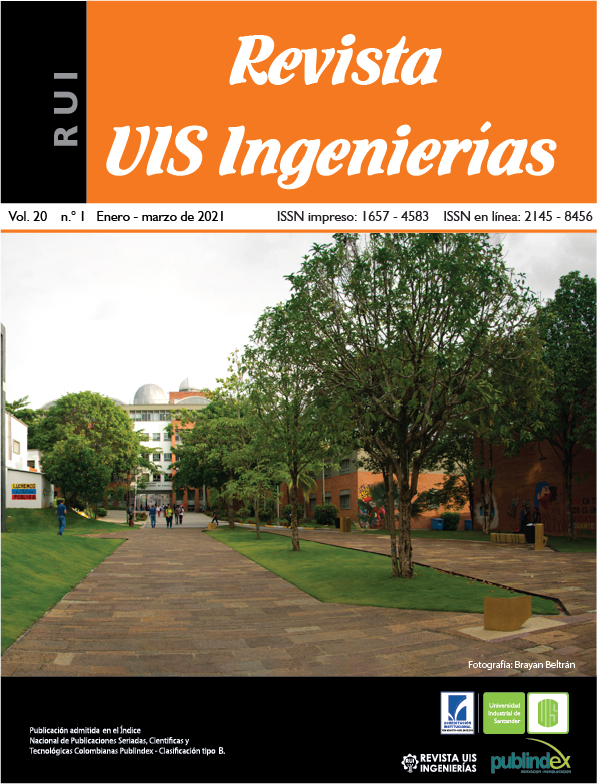Publicado 2020-11-05
Palabras clave
- equilibrio vapor-líquido,
- coeficiente de fugacidad,
- coeficiente de actividad,
- Peng Robinson,
- Van Laar
- Azeótropo ...Más
Cómo citar
Derechos de autor 2020 Revista UIS Ingenierías

Esta obra está bajo una licencia internacional Creative Commons Atribución-SinDerivadas 4.0.
Resumen
El presente artículo tiene como propósito mostrar la predicción del equilibrio vapor-líquido de una mezcla no ideal mediante modelos termodinámicos como lo es la ecuación de Peng-Robinson para el cálculo de los coeficientes de fugacidades de los componentes en estado gaseoso, y el modelo de Van Laar para hallar los coeficientes de actividad de los componentes en estado líquido. Los resultados se validan mediante el uso del simulador comercial Aspen Plus y la herramienta online “VLE-Calc”, obteniendo resultados similares con los valores experimentales de la mezcla binaria.
Descargas
Referencias
[2] P. M. Mathias, “Effect of VLE uncertainties on the design of separation sequences by distillation – Study of the benzene–chloroform–acetone system”, Fluid Phase Equilibria, vol. 408, pp. 265-272, 2016, doi: 10.1016/j.fluid.2015.09.004
[3] G. González, N. Prieto, I. Mercado, “Large Eddy Simulation (LES) Aplicado a un lecho fluidizado gas–sólido. Parte I: Reactor a escala de laboratorio”, Revista UIS Ingenierías, vol. 17, no. 1, pp. 93-104, 2018, doi: 10.18273/revuin.v17n1-2018009
[4] G. González, N. P. Jiménez, O. F. Salazar, “Fluid Dynamics of Gas-Solid Fluidized Beds”, en Advanced Fluid Dynamics, 2012, pp. 39.
[5] S. I. Sandler, Models for Thermodynamic and Phase Equilibria Calculations. Taylor & Francis, Boca Raton, FL, USA: CRC Press, 1993.
[6] A. Zinser, K. Ye, L. Rihko-Struckmann, K. Sundmacher, “A Dynamic Method for Computing Thermodynamic Equilibria in Process Simulation”, en Computer Aided Chemical Engineering, vol. 37, Elsevier, 2015, pp. 299-304.
[7] N. P. Jiménez, G. G. Silva, “Comparative Study of Equations of State for the Dew Curves Calculation in High Pressure Natural Gas Mixtures”, Revista Logos Ciencia & Tecnología, vol. 11, no 1, pp. 152-164, 2019, doi: 10.22335/rlct.v11i2.743
[8] I. Mertl, “Liquid-vapour equilibrium. IL. Phase equilibria in the ternary system ethyl acetate-ethanol-water”, Collect. Czech. Chem. Commun., vol. 37, no. 2, pp. 366-374, 1972, doi: 10.1135/cccc19720366
[9] H. Kuramochi, K. Maeda, S. Kato, M. Osako, K. Nakamura, S. Sakai, “Application of UNIFAC models for prediction of vapor–liquid and liquid–liquid equilibria relevant to separation and purification processes of crude biodiesel fuel”, Fuel, vol. 88, no. 8, pp. 1472-1477, 2009, doi: 10.1016/j.fuel.2009.01.017
[10] I. R. Navarro-Espinosa, C. A. Cardona, J. A. López, “Experimental measurements of vapor–liquid equilibria at low pressure: Systems containing alcohols, esters and organic acids”, Fluid Phase Equilibria, vol. 287, no. 2, pp. 141-145, 2010, doi: 10.1016/j.fluid.2009.10.002
[11] J. Dhanalakshmi, P. S. T. Sai, A. R. Balakrishnan, “Effect of Inorganic Salts on the Isobaric Vapor–Liquid Equilibrium of the Ethyl Acetate–Ethanol System”, J. Chem. Eng. Data, vol. 58, no. 3, pp. 560-569, 2013, doi: 10.1021/je300886k
[12] J. G. Veneral et al., “Thermophysical properties of biodiesel and related systems: Low-pressure vapour–liquid equilibrium of methyl/ethyl Jatropha curcas biodiesel”, The Journal of Chemical Thermodynamics, vol. 60, pp. 46-51, 2013, doi: 10.1016/j.jct.2013.01.018
[13] P. Murti, M. Van Winkle, “Vapor-Liquid Equilibria for Binary Systems of Methanol, Ethyl Alcohol, 1-Propanol, and 2-Propanol with Ethyl Acetate and 1-Propanol-Water”, Ind. Eng. Chem. Chem. Eng. Data Series, vol. 3, no. 1, pp. 72-81, 1958, doi: 10.1021/i460003a016
[14] A. Randová et al., “Separation of azeotropic mixture acetone + hexane by using polydimethylsiloxane membrane”, Separation and Purification Technology, vol. 170, pp. 256-263, 2016, doi: 10.1016/j.seppur.2016.06.061
[15] S. Yuan, C. Zou, H. Yin, Z. Chen, W. Yang, “Study on the separation of binary azeotropic mixtures by continuous extractive distillation”, Chemical Engineering Research and Design, vol. 93, pp. 113-119, 2015, doi: 10.1016/j.cherd.2014.05.005
[16] A. Iqbal, S. A. Ahmad, “Pressure swing distillation of azeotropic mixture – A simulation study”, Perspectives in Science, vol. 8, pp. 4-6, 2016, doi: 10.1016/j.pisc.2016.01.001
[17] L. E. Øi, J. Hovland, “Simulation of Condensation in Compressed Raw Biogas Using Aspen HYSYS”, en Linköping Electronic Conference Proceedings, 2018, pp. 31-36, doi: 10.3384/ecp1815331
[18] D. F. Samayoa Alvarado, “Desarrollo de un sistema tutorial inteligente (STI) de procesos de destilación utilizando los programas Simulis Thermodynamics V.2.0. y Aspen Hysys V.8.0.”, tesis de grado, Universidad de San Carlos de Guatemala, 2018.
[19] K. Darkwah, S. E. Nokes, J. R. Seay, B. L. Knutson, “Mechanistic simulation of batch acetone–butanol–ethanol (ABE) fermentation with in situ gas stripping using Aspen Plus TM”, Bioprocess Biosyst Eng, vol. 41, no. 9, pp. 1283-1294, 2018, doi: 10.1007/s00449-018-1956-6.
[20] D. Singh, R. K. Gupta, V. Kumar, “Experimental studies of industrial-scale reactive distillation finishing column producing Ethyl acetate”, Industrial and Engineering Chemistry Research, vol. 53, no. 25, pp. 10448-10456, 2014, doi: 10.1021/ie404443g
[21] A. Hasanoğlu, Y. Salt, S. Keleşer, S. Özkan, S. Dinçer, “Pervaporation separation of ethyl acetate–ethanol binary mixtures using polydimethylsiloxane membranes”, Chemical Engineering and Processing: Process Intensification, vol. 44, no. 3, pp. 375-381, mar. 2005, doi: 10.1016/j.cep.2004.06.001
[22] B. E. Poling, J. M. Prausnitz, J. O. Connell, The Properties of Gases and Liquids, 5.a ed. New York, NY, USA: McGraw-Hill Professional, 2000.
[23] H. G. Rackett, “Equation of state for saturated liquids”, J. Chem. Eng. Data, vol. 15, no. 4, pp. 514-517, oct. 1970, doi: 10.1021/je60047a012
[24] J. M. Smith, H. C. V. Ness, M. M. Abbott, Introduction to Chemical Engineering Thermodynamics, 7th Edition. Boston, MA, USA: McGraw Hill Higher Education, 2005.
[25] G. Figurski, S. K. Malanowski, “Vapor–liquid equilibrium studies of the ethanol+ethyl acetate system”, Fluid Phase Equilibria, vol. 148, no. 1-2, pp. 161-169, 1998, doi: 10.1016/S0378-3812(97)00341-5

